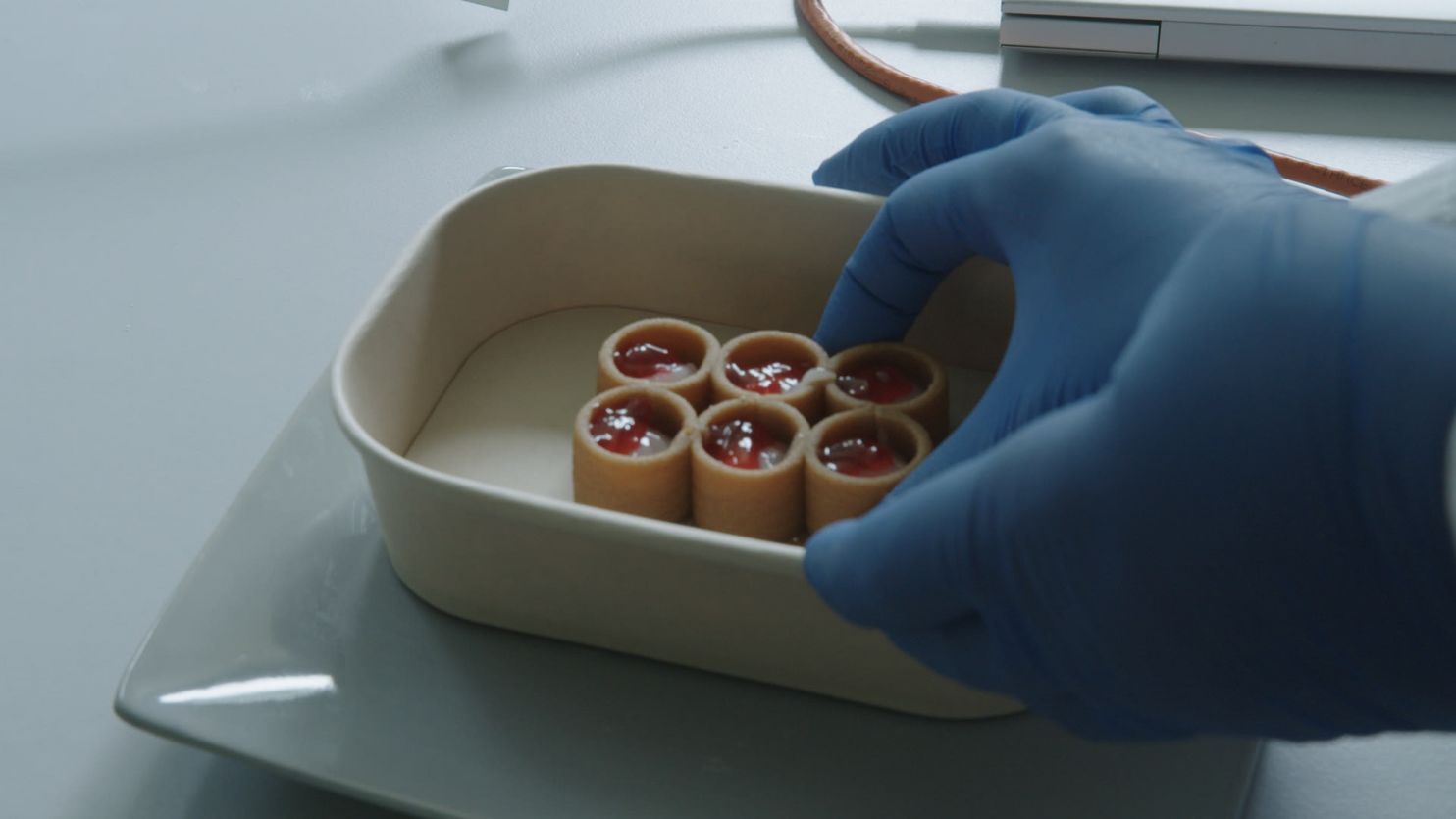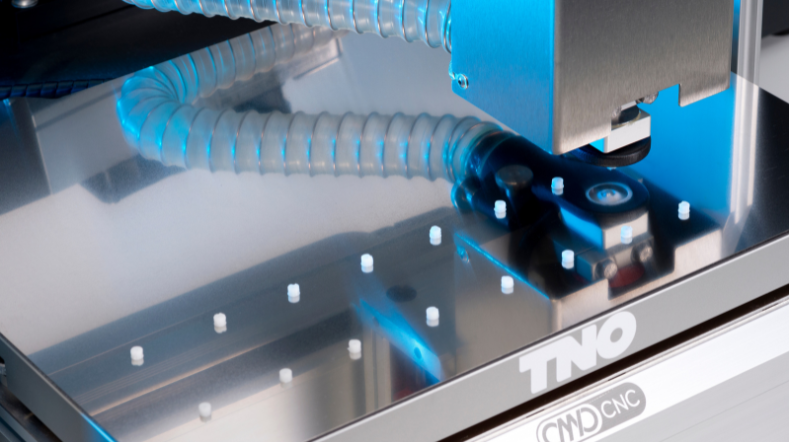
3D printed food: the future of personalised nutrition
Everybody is different and so we all need different nutrients. The nutrition our bodies require also varies from one moment to the next. Personalised nutrition can help people live healthier lives and improve performance and recovery. To investigate how, TNO, Wageningen University & Research and partners developed an innovative mobile mini-factory for 3D- printed food.
We are getting older and, at the same time, we live unhealthier lives. The average age people started suffering from chronic conditions was 55 years in the 1980s; today this has dropped to 43 years. Many of these chronic conditions are lifestyle-related. TNO is investigating various health interventions with collaborating parties to reverse this trend. It turns out that customisation helps in sustaining the interventions and in their effectiveness. Personalised nutrition plays an important role this customisation.
Personalised nutrition also offers opportunities for other societal challenges. The number of people with food allergies is rising and in today's 24-hour society it is important to perform optimally at any time of day. Personalised nutrition fits within a wider trend in which health is becoming increasingly customised, boosted by developments such as smartwatches that measure your heart rate and blood pressure, personal health platforms, genetic passports and self-testing, among others.
Benefits of 3D food printing
Until now, personalised nutrition focused on recommending the right foods within the existing offer. People were given shopping lists, for example, or recipes or personalised meal boxes, but they still had to prepare the meals themselves.
With 3D food printing, an interesting next step is coming into view: the production of ready-made personalised foods. In 3D food printing, the printer's container ('cartridge') is filled with a food product, e.g. dough, after which the print head builds up the food product layer by layer on a plate. This printing technology is combined with advanced dispensing and filling techniques.
The big advantage of 3D food printing is that these machines can print different products and make adjustments in real time. In this way, individual food products can be made that vary in calories, macro-nutrients, micro-nutrients, texture, shape and taste. Products that suit a person's personal needs and preferences as well as his or her activity level of that day. In contrast, traditional food products are made on a massive scale, meaning that any changes often require modification of the entire production chain.
Multi-disciplinary innovation
TNO has a wide variety of in-house disciplines relevant to both health, food production and 3D printing. These include nutritionists, system biologists, behavioural scientists, bio-informaticians, data scientists, system engineers, software developers and mechanical engineers. This unique combination of knowledge and expertise allowed TNO - together with partners - to develop an innovative 3D food printing system in a mobile kitchen.
In this mobile kitchen, so-called 'Nutri-Bites' are produced. The printing process consists of several steps. The machine first prints a dough base, which is then baked in the oven and filled by the machine. For this innovation, TNO is working closely with Wageningen University & Research (WUR). Together with the other partners, nutrition technologists from the WUR have developed the doughs, fillings and toppings for the Nutri-Bites.
Personal recipe
Personalisation of the Nutri-Bite is not just about a 3D food printer. First a software platform is used to create a personalised nutritional advice. People fill in a questionnaire about, among other things, their physical characteristics, medical situation, any complaints or sensitivities, their nutritional goals and taste preferences. The answers are combined with the results of individual measurements, such as height, weight and body type, and personal information, such as age and gender. Algorithms then translate this data - based on scientific knowledge - into nutritional advice.
Based on this, the ideal composition of volume, macro-nutrients (such as fats, carbohydrates and proteins), micro-nutrients (vitamins, minerals) and other nutrients is determined. This is sent to the 3D printer as a 'personal recipe' and then made into a Nutri-Bite. With this system, over 50,000 different variants of the Nutri-Bite can be produced, each with a different volume and a different combination of nutrients.
Testing in the field: soldiers and hospital patients
Together with its partners, TNO investigated whether Nutri-Bites could be produced for different individuals, targets and circumstances. And - not least - whether the target groups found the products acceptable as food and had the impression that it helped them boost performance and recovery or mitigated complaints.
Two field studies were set up. In the first one we tested whether Nutri-Bites could support military personnel in performance enhancement and endurance. Before the test, soldiers filled in a questionnaire about their personal characteristics, dietary habits and needs. This resulted in various nutritional recommendations with a unique Nutri-Bite for every soldier. These were then put to the test as the soldiers performed various physical exercises. In the second study, we examined whether the Nutri-Bites could support hospital patients in their recovery. Again, the same production system proved capable of providing everyone with unique Nutri-Bites. In both cases, the target group found the Nutri-Bites acceptable.

Closing the gap between advice and practice
This is the first time that personalised nutritional advice was directly converted into a ready-to-use product. This makes it easier to apply nutritional advice in practice. Also, with the Nutri-Bite, a person gets much of what he or she needs with one product, whereas this normally requires several products. Therefore, this innovation offers many new opportunities, both for societal challenges such as understaffing in healthcare, and for business.
As the field studies show, the 3D printing system can be used to optimise nutrition for performance or recovery, tailored to individual needs, preferences and the circumstances of that day. This is interesting for different target groups, such as (top) athletes, hospital patients, people with serious diseases, the elderly and people rehabilitating at home after an accident or surgery. Or for people with a demanding profession, such as military personnel, police officers, firefighters, nightshift workers or healthcare staff.
Lowering threshold for healthy eating habits
The 3D printing system and associated platform can also be used for a wider audience to promote a healthy lifestyle. With the platform, people can - wherever and whenever they want – request personal nutritional advice. And whether in the future they will order the associated product from a manufacturer, print it at the supermarket or gym, or maybe even have a printer at home: they will get a ready-made snack with a composition that is optimal for them.
So, the innovation could potentially contribute to preventing or delaying lifestyle-related diseases, and ease the pressure on the healthcare system. Moreover, it could boost a healthy lifestyle or a specific need (e.g. performance, concentration or recovery).
Next steps
Various directions are possible for further development, such as refining and accelerating the production process, or developing other products. In addition, the food platform and its ingredients can be further developed to serve more target groups. In any case, it is clear: 3D food printing makes producing personalised food products more feasible and accessible.
*Partners in the 3D food printing project (project IMAGINE) are Wageningen University & Research, TNO, the Ministry of Defence, Gelderse Vallei Hospital, GEA Group, SoliPharma B.V., Tate & Lyle, Nissin and General Mills.
The public-private partnership in the IMAGINE project is partly funded by the Ministry of Economic Affairs, through Top Sector Life Sciences & Health, grant numbers 21074 (WFBR) and 100340397 (TNO) and through Top Sector High Tech Systems and Materials, grant number 100340397 (TNO).
Get inspired
3D pharma printing: Personalised medicine begins here


TNO launches digital health spin-off AIKON Health for wearable monitoring


UK MasterChef winner Tim Anderson experiments with 3D printed pasta


The future of 3D-printed food made possible


3D printing for flexible production of personalised medicine


